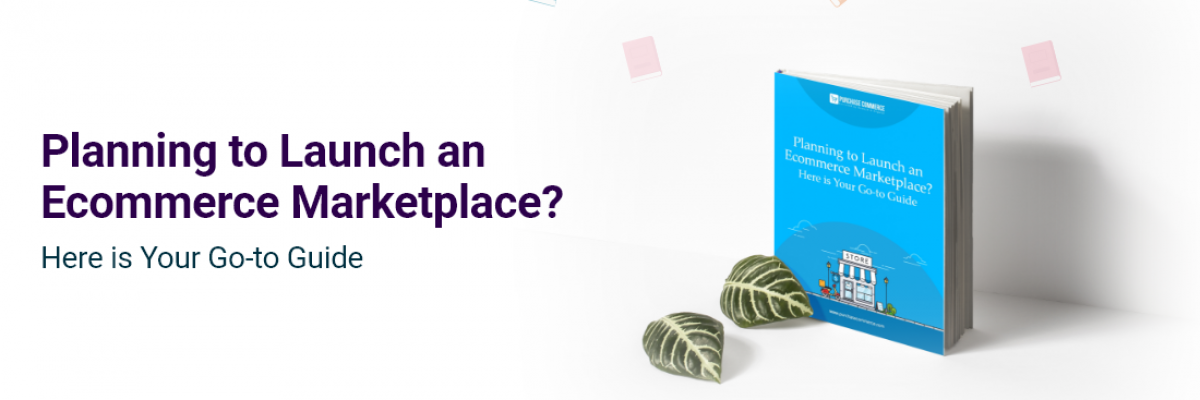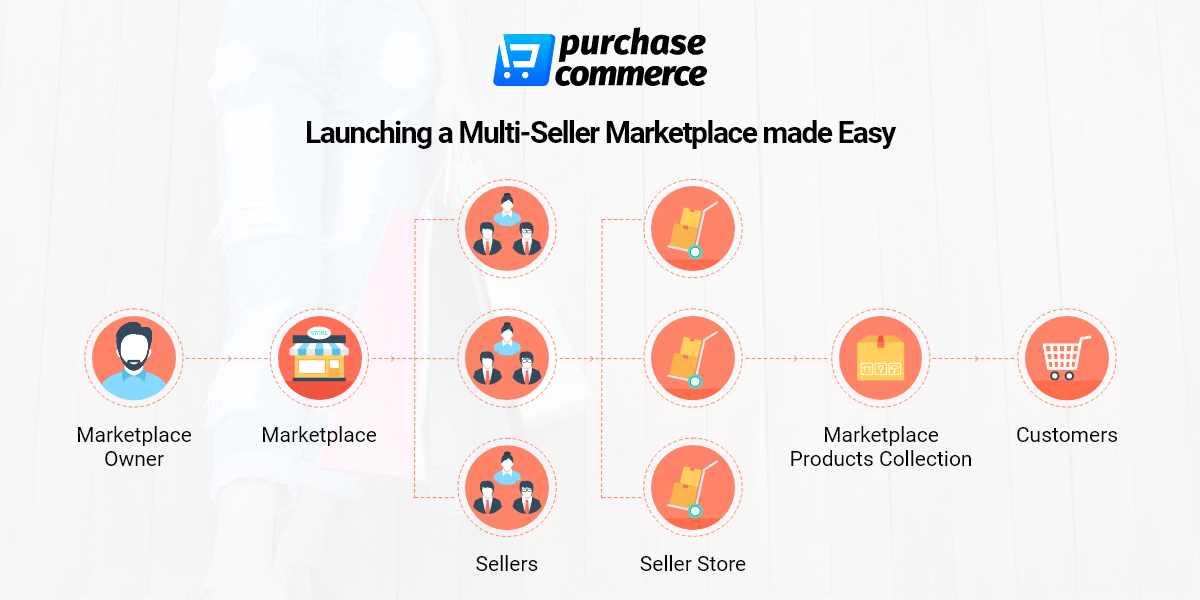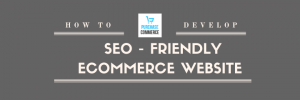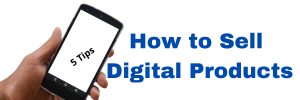Planning to Launch a Multivendor Ecommerce Marketplace? Here is Your Go-to Guide
Ecommerce marketplace businesses are all the rage these days as they provide a host of benefits to both modern consumers and businesses who have shifted their interaction online. As per the latest report from Internet Retailer, the marketplace sales grew 20% in 2018 and it accounted for more than 50% of global online retail sales last year.
Going ahead, these numbers are expected to increase. So, if you think it is the right time to launch your marketplace, then it is none other than yesterday. You have already missed some huge opportunities. However, if you launch your marketplace business today with the right marketplace software, you can still stay ahead in the ecommerce race.
What is an Ecommerce Marketplace?
An ecommerce marketplace is a type of website or mobile apps where products or services from multiple third-party vendors are displayed on a common storefront for buyers to choose from.
-
For buyers, the marketplace provides them with an array of products, where they can order products together from several different ecommerce vendors while being able to pay all them in one transaction.
-
For vendors, the marketplace provides an opportunity for them to sell products like big international companies. It enables them to focus on their core business like product development instead of spending time on logistics. Even smaller vendors can make more profit and grow their business.
-
To facilitate smooth business between the vendor and buyer, the marketplace operator handles payments and generates revenue via fees to manage the marketplace platform.
One of the main advantages of ecommerce marketplaces is that they draw more visitors due to its network effect that is baked into the marketplace model. The network effects are the fundamental digital foot traffic gained by the vendors of the marketplace for each new vendor that joins the platform.
Getting started with the ecommerce marketplace
Foremost, the significant investment for your business is buying the marketplace software and the domain name. Finding the perfect software comes with its unique set of challenges. It has to fit your strategic business requirements and provide you with the apt business model.
But the question is how do you select such software. What are the areas you do brainstorming before finalizing one? If you are selecting just any of the available marketplace software and then sticking to only those business plans that are supported by that software, it will not make your business profitable in the long run. Therefore, before concluding the right marketplace software, you should be aware of the below step-by-step process to launch a successful marketplace business.
So, are you ready to start your ecommerce venture? In this guide, you'll learn all the required steps – from carrying out market research and choosing the right business model to list out the essential features and launching your marketplace business in a phase by phase manner.
1. Get a better understanding of your target market
Whether you are looking for a marketplace software or creating a marketplace website from scratch, there's no way around doing your market research. Starting an ecommerce marketplace without having a clear knowledge of the target market makes you learn painful lessons, and it is not the right way to start your business.
To build a viable marketplace business, you need to understand the market better and also what your users are looking for, their needs and the solution. As per the analysis, online marketplaces are more successful when they center around one particular niche because it provides the buyers the reason to shop there and what they can expect from the vendors.
Access the market: The more you understand the market; it is more likely that you'll be choosing the most attractive niche for your users. Also, analyze whether the business model that you have in mind makes sense for your target market and its users. It makes sense to research the competitors in your target market – their strengths as well as weakness.
Solve your users’ problem: You’re building the marketplace to meet a particular purpose for your users. So, if you don't know about their problems, you can't attain the purpose. Since you're building a two-sided marketplace - for buyers and vendors – you’ve to come up with solutions for both sides to solve their problems and help them to achieve their goals.
Coming up with solutions: When you’re trying to solve your users’ problem, it allows you to select a suitable niche for your online marketplace. Design a solution based on this purpose, draw up a business model that makes sense and prepare a launching strategy that will make your marketplace site stand apart for the competitors.
By now you should have a clear understanding of your users, their problems and your product niche. So, go ahead and start having a conversation with your users to get their opinions.
2. Choose a profitable and viable business model
For every business to run, it needs a revenue model. Online marketplaces are no exception to this. Helping your users to solve their challenges isn't just sufficient for your business to succeed. You have to make your marketplace profitable to sustain your business in the long run.
When Amazon started, it took them more than 6 years to have its first profitable quarter in 2001. So, no matter what is your product niche, it's always a good idea to have a viable business model in place from the launch of your online marketplace, not in the middle of your ecommerce journey.
Here are some Important Business Models that you may need to consider.
Sign-up fees: A sign-up fee is a flat payment that you may charge your vendors while they join your marketplace. This model works perfectly if you can sell your vision to new vendors and the great thing about this is that you can charge vendors even before you have a thriving business.
Even though, sign-up fee model works well for a new business; it has a major disadvantage where you can’t get monetization from your vendors regularly. You will also have to prove that your platform is worth it for them to pay the sign-up fee upfront.
Subscriptions: One of the best business models that powers the global sharing economy is subscription-based businesses that generate recurring revenues. It is the specific amount that your vendor pays you regularly to keep your marketplace running. In this model, you have to ensure your vendors get more value out of your marketplace than it costs them to stay subscribed.
To generate a steady recurring revenue stream, you can combine this idea with multiple different tiers like basic, pro or advanced that let vendors unlock more features when their business grows.
Listing fees: This is another type of business model where you collect a listing fee from your vendors when they list their items for sale. Listing fees can be flat or variable amounts based on the products’ price, category, etc.
You can also make this more focused by charging vendors based on their hierarchy. Likewise, subscriptions, vendors will usually be fine with a minimum insertion amount to list their item as long as they make a profit out of your marketplace.
Selling fees: This model is a great monetization strategy if you do it perfectly. You can charge vendors for every successful order or you can charge them after their total income reaches a certain amount. With this model, you can ensure more revenue for you, if more orders are placed on your marketplace.
The only downside is that it is difficult to implement selling fees in your marketplace when compared to other types of fees. You can set-up this model automatically with the help of a payment gateway that splits buyer payments to receive your fee at the time of sale.
3. Create a list of must-have Marketplace Features
Now that you’ve designed the business model for your marketplace. It’s time to list all the must-have features. You'll never know what your users expect from your marketplace after it is launched. So, it is easy to waste time, budget and effort by creating features your users don’t need.
As general advice, it’s greatly recommended to launch a minimum viable product (MVP) early with only the basic functionality in place. You can add extra features when your business grows, and the requirement gets clearer.
Having said that, what is the minimum viable product for your marketplace? We have divided the functionalities into three major categories – vendors, buyers, and essential platform features.
Must-have Vendor Features: The first thing is, you have to make it easy for your vendors to join the marketplace. Hence, it’s important to streamline the onboarding process. A great onboarding process includes clear vendor terms and helpful landing pages, straightforward vendor sign-up and an easy way to import and manage their product catalog.
Secondly, your vendors want to sell their items and get paid. This means they should have an intuitive dashboard for listing, selling and dispatching products efficiently. Next, your marketplace should make it easy for your vendors to receive and process orders. Notifications are a must to ensure orders don't go unnoticed. To make selling and marketing easier, offer your vendors at least the basic sales and marketing tools – such as coupon code management and product promotions.
Finally, ensure your vendors can freely communicate with you and the buyers. Product reviews & ratings along with a private messaging system will be a good start.
Must-have Buyer Features: Intuitive user interface is one of the main features your buyers wish to have in the marketplace once they login to their account or even as a guest user. It should make it easier for your buyers to search for products and browse categories. Order Management features like a Wish list and Add to cart is more important to the buyers for them to purchase later.
Seamless transaction and single payment check out the process making it simple to purchase products from multiple vendors. Moreover, make it easy for your buyers to view and track their orders, as well as get notified when the status changes.
Communication is crucial, too. Allow your customers to ask vendors order-related questions and leave feedback. This will ensure your platform provides a great buying experience and helps retention.
The must-have platform features: To keep your marketplace up and running, you will need a way to monitor, manage and control everything that happens on your platform.
You will also want to customize the appearance of the marketplace storefront without digging into code. This will make it easier for you to make seasonal offers, introduce new products and categories, run marketplace-wide promotions and feature your bestsellers and products.
Advanced Marketplace Features: There are much more platform features for your users down the road:
-
Reporting tools
-
Advanced selling and marketing tools
-
Abandoned shopping cart
-
Third-party integrations
-
Mobile apps, PWA and more
4. Indispensable Marketplace Integration
Your platform is not a full-fledged marketplace unless it has the functionality to integrate third-party apps to solve the user's purpose. It's not a sustainable business if your marketplace platform can't process payments securely, deliver products efficiently and send out quick notifications.
Payment Gateway: Your marketplace is part of the global payment ecosystem, but there are a few unique challenges marketplace businesses deal with compared to regular ecommerce businesses when it comes to payment processing.
You should know the following different payment types you'll be processing as a marketplace owner:
-
payments from buyers (customers purchasing products)
-
payments from vendors (sign up, listing, subscription fees, promotions)
-
payments to vendors (payouts)
-
other payments (third party advertisers or affiliates)
Shipment Gateway: The right kind of shipment gateways allow marketplaces to speed up the revenue by simplifying the purchasing process for buyers. The efficient and secure delivery process can influence buyers, drive sales, and create return visitors.
The study revealed that 45% of customers have abandoned a shopping cart because of unsatisfactory delivery options, 38% say that negative delivery experience is a deal-breaker, because of higher shipping costs 66% of shoppers claim they’ve decided not to purchase. Therefore, the shipping price and speed are two of the top three most influential factors driving more purchases.
Decide a shipment gateway solution that suits your ecommerce site. You have to look for third-party logistics services that have a good reputation in your target region with the following benefits:
-
Lower costs and better profit margins
-
Better shipping processes and throughput
-
Less likelihood of damage during shipment
-
Wide geographic serviceability
-
Easy API integration
Communication Gateway: As an ecommerce marketplace owner, you have to launch promotions, transaction emails, and recover abandoned carts. Ecommerce systems can greatly benefit from the integration end by leveraging the API of third-party service providers for email, SMS, etc.
For an ecommerce business that is striving to retain customers through their service, the older timer ‘SMS’ is the best way to communicate. With a high open-rate of over 98% and the lowest possible cost SMS fits the bill of all sorts of ecommerce businesses.
Emails are used for a variety of purposes like product promotions, informing about the latest product additions, educating and sharing newsletters, sending confirmation at various stages and many other similar scenarios. Setting up an automated and personalized email series based on the recipients' recent activities bring in more sales for your store.
Sending regular notifications to customers, sellers and admin is an essential part of a marketplace site. So, choose the perfect communication gateways for email and SMS.
5. Choose the Right Hosting Solution
Once you have chosen the perfect marketplace software as a wish, it’s time to think about hosting solutions. Here we discussed the basic three hosting solutions – shared, dedicated and cloud. Selecting the right one depends on your business requirements but it is always wise to choose cloud hosting as it provides a high level of flexibility and scalability.
Shared Hosting: Today, shared hosting is the most economical solution and is suitable for blogging or corporate websites with moderate traffic (mostly static websites).
This solution is suited for individuals with less technical skills because the host provides you with a complete administration system and takes care of all the features related to the hosting system (update, security, maintenance, backups, software installation, etc.).
Dedicated Hosting: With dedicated hosting, you can hire or purchase a full server. This type of hosting is suitable for websites that generate numerous traffic and require a lot of resources (examples: marketplace, ecommerce, social networks).
Although no server can firmly guarantee 100% security, a dedicated server remains the best choice to adopt if the security of your ecommerce website is your priority. As you do not have to share bandwidth with other websites, the dedicated servers are faster and you can host multiple websites, and it can withstand unlimited traffic. Nevertheless, they are more expensive.
Cloud Hosting: Cloud is trustworthy because if one of the servers fails, your website will not crash because it will use the resources of another cloud server. It has benefits such as:
On-demand resources: With cloud servers, you’re free to request resources on the fly and, in general, pay on time.
High Availability: Unlike on-premise physical servers, virtual machines transfer data to another machine without downtime in the event of a hardware failure. The stability of cloud servers is unmatched in the field of web hosting.
Scalability: With more resources and faster access to them, cloud hosts offer incredible scalability for customers. This is why these types of servers are used for other cloud-based services, collectively known as cloud hosting.
6. Launch your Marketplace Business in a Phased Manner
Roll out in a particular target region: Start building anticipation for your marketplace among your target customers and vendors while it's still in development.
If you've done your market research, you already know who your users are. Now, interact with them – directly, on social media, through an online survey, and via advertisements.
Start building an audience list way before the initial launch – this will let you know their interest and provide you with a user base of early adopters.
By the time you have your MVP ready for testing, you should have a set of users who know about your marketplace and are willing to experience new features in your marketplace.
Roll out a limited beta version: No matter how well-designed your marketplace or how detailed the functionalities and features, you will confront all kinds of challenges at first – from software glitches to usability problems to missing or lacking features.
Therefore, it's a great idea to have a minimal release of your MVP at first before its grand launch to test things out and ensure everything works just as expected.
Don't wait too long to try different things and introduce your marketplace to early beta users – do a soft launch when you have your MVP ready, possibly even sooner.
Collect feedback: Now, gather as much feedback as you can – in any possible way. Then, iterate and improve – spend as much time as you need to improve your MVP based on the feedback you receive from the soft launch of your marketplace.
A thing to remember – don't just use your early adopters as test subjects, but try to establish real relationships and build trust with them. This trust will help you promote and grow your marketplace in the early stages of your business.
Enhance your platform: By now, people are aware of your new ecommerce marketplace. So, it's time to make it officially public to a large group of users.
Run a final set of tests beforehand to ensure everything is working just as expected. Have your team ready for launch – things tend to break down when you least expect them to be in that way.
Whatever your marketplace’s business model, try to make an event out of your launch. Make your marketplace popular in regions where your target users are present and bring your launch to them through a webinar or live events.
Final Thoughts
Now that you have launched your marketplace business. But it’s not the end of the story. There are necessary next steps as mentioned below to keep your ecommerce marketplace up and running more efficiently. They are:
-
Planning the workflow and managing the marketplace
-
Promoting your marketplace business
-
Adopting various sales strategies
-
Tracking the performance of your business
Purchase Commerce will help you start your ecommerce multi-vendor store easily and make you stand out against competitors with a fine-tuned and ecommerce store according to your business needs and that grows at every step.









